|
(October 2005)
What are the experts saying about the 2005 FIDE World Championship, San Luis, Argentina?
•
'One of the most exciting world championships in memory' [ChessBase.com]
•
'Will go down in history as one of the finest tournaments of all time' [GM Nigel Short, WccSanLuis.net]
•
'An event that will be remembered for a long time' [GM Susan Polgar, SusanPolgar.blogspot.com]
What made the event a success? First and foremost, it was the combative quality of the participants, especially of the eventual winner Topalov. He beat all but one of his rivals in the first half of the tournament, before coasting to victory in the second half.
The Official Site

www.wccsanluis.net
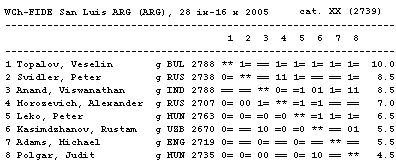
Source:
The Week in Chess
To get a feel for the flow of the event by top grandmasters, see the commentaries by GMs Nigel Short and Sergey Shipov in the link box at the bottom of this article.
Short's comments, written at San Luis in the thick of the battles, give a high level feel for the round by round action.
Shipov's comments are more detailed and annotate the games in depth.

The red '*' marks San Luis.
Image: Perry-Castañeda Library Map Collection
Courtesy of The General Libraries, The University of Texas at Austin.
To play through all the games of the tournament using the About Chess game viewer, see also the link box.
***
One of the many qualities that determine a good chess game is a surprising sacrifice. The San Luis event was full of excellent sacrifices. Let's look at a few from the first half of the tournament.
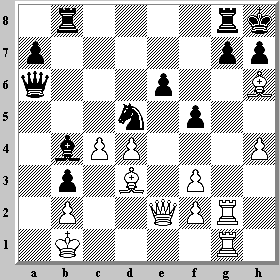 |
Anand |
| Round 1; after 34.Bg5-h6 |
| Polgar |
The first round saw an example of a sacrifice to force an immediate win in an overwhelming position.
In the diagrammed position, Anand played 34...Nc3+. Polgar accepted the sacrifice with 35.bxc3, but was forced to give up after 35...Bxc3 36.Kc1 Qa3+ 37.Kd1 Qa1+ 38.Bc1 b2 39.Qe3 Bxd4 40.Qd2 bxc1=Q+ 41.Qxc1 Qa2.
If White declines the sacrifice with 35.Kc1, then 35...Nxe2+ wins the Queen, but 35...Qa1+ 36.Bb1 Qxb1+ mates.
Such sacrifices are the bread and butter of good players (and of puzzle anthologists).
|
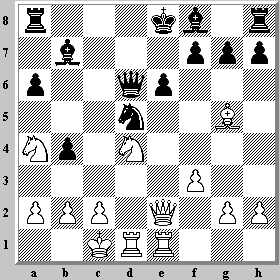 |
Topalov |
| Round 1; after 16...Qc7-d6 |
| Leko |
Also in the first round, a sacrifice that wasn't made may have had a critical impact on the final standings.
In the diagrammed position, between two of the pre-tournament favorites, White is fully developed. Black has three pieces on their original squares with the King in the center.
Leko played 17.Kb1, and the game continued 17...h6 18.Bh4 Nf4. Topalov managed to get out of trouble and eventually won.
If Leko had played 17.f4, threatening 18.f5, the result of the game and of the tournament might have been completely different.
Accepting the Pawn sacrifice with 17...Nxf4 is bad because 18.Qg4 Nd5 19.Nxe6 wins easily.
The move 17...h6 runs into 18.Nxe6 Qxe6 (18...fxe6 19.Qh5+ Kd7 20.Qf7+ Kc8 21.Rxe6 Qd7) 19.Qd3 pinning the Queen.
Even the straightforward 17...Be7 loses to 18.Nf5 exf5 19.Bxe7.
What did Topalov have in mind as a defense? Perhaps 17...g6 to defend the f5-square and to close the d8-h5 diagonal, although this does nothing to further Black's development.
|
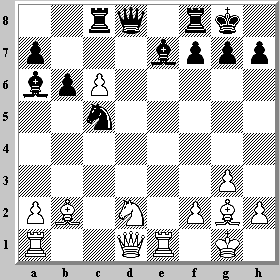 |
Anand |
| Round 2; after 18...Nd7-c5 |
| Topalov |
Looking at the games between top players, it's not always easy to spot the difference between a real sacrifice and an unusual piece exchange. The diagrammed position is a good example.
White played 19.Nc4. This is not a real sacrifice because 19...Bxc4 20.Qg4 threatens mate and recaptures the piece on the next move.
After 20...Bg5 21.Qxc4 Nd3 the real sacrifice is 22.Ba3, because 22.Re2 fails to 22...Nxb2 23.Rxb2 Bf6.
The game continued 22...Nxe1 23.Rxe1 (not 23.Bxf8 Nxg2 24.Ba3 Ne3 25.fxe3 Bxe3+ 26.Kg2 Qf6) 23...Re8 and was eventually drawn on the 97th move.
|
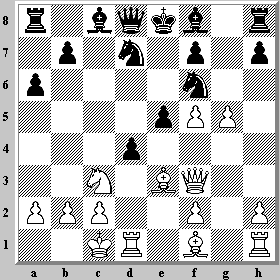 |
Kasimdzhanov |
| Round 3; after 12...Nb8-d7 |
| Polgar |
Once a sacrifice has been made and the position has become unclear, further sacrifices often follow.
Count the minor pieces in the diagrammed position, and you will discover that White has already sacrificed a Knight for a Pawn.
Now 13.Bxd4 sacrifices a second piece for two more Pawns. Play continued 13...exd4 14.Rxd4 Bg7.
If 14...Bc5 15.Rd2 Ng8, trying to hold onto the extra piece, White has 16.f6. Now how will the Ng8 and Rh8 be developed? If 16...h6 then 17.Qh5.
Now came 15.Rg1 Kf8, and Polgar eventually won. This is a great example showing why the world's strongest woman player deserves her reputation as a fierce competitor.
|
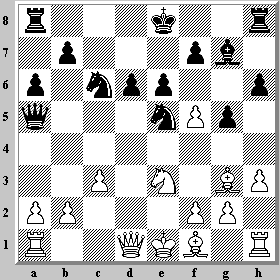 |
Topalov |
| Round 5; after 15.c2-c3 |
| Svidler |
One of the stock tricks for undertaking a sacrifice is to have one variation good for at least a draw. Sometimes it involves a variation that the sacrificing player can bail into, and sometimes it involves a variation that the opponent can choose. In both cases, it's protection against an unforeseen complication. When the worst case is a draw, the risk is reduced.
In the diagrammed position, Topalov played 15...Nf3+ 16.Qxf3 (not 16.gxf3 Bxc3+ 17.bxc3 Qxc3+ 18.Ke2 Nd4+ winning the Queen), followed by 16...Bxc3+ 17.Kd1 Qa4+ (17...Bxb2 18.fxe6).
The game continued 18.Nc2 (if 18.Kc1 Bxb2+ 19.Kxb2 Qb4+ 20.Kc1 Nd4 and Black has a perpetual check)
18...Bxb2 19.fxe6 fxe6 20.Qb3 Qxb3 21.axb3 Bxa1 22.Nxa1. Black had a Rook and two healthy center Pawns, one of them
passed, in return for two Bishops.
|
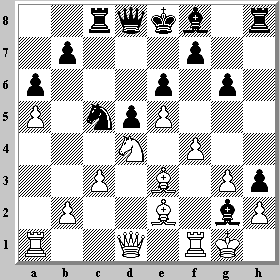 |
Anand |
| Round 7; after 20...Be4-g2 |
| Morozevich |
One of the hallmarks of modern chess is the positional exchange sacrifice. In the diagrammed position most players would automatically play 21.Re1.
Morozevich, who marches to a different drum, probably decided that it was better to eliminate the annoying Bg2 with the Rook instead of with his own light squared Bishop. The Bishop exchange would leave White with a bad Bishop and Black with a good Bishop.
The Russian played 21.Rf2, the game continued, 21...Ne4 22.Rxg2 hxg2 23.Kxg2. The Indian resigned on his 50th move.
|
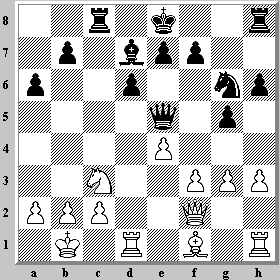 |
Polgar |
| Round 7; after 19.Qd4-f2 |
| Svidler |
Some sacrifices just don't work.
Svidler undoubtedly calculated the consequences of 19...Rxc3.
Polgar undoubtedly saw nothing better, and the game continued 20.bxc3 Qxc3 21.Rd3 Qa5 22.Qe3 Be6 23.Ra3 Qb4+ 24.Ka1 Kd7 25.Be2.
Here Black felt compelled to offer the exchange of Queens with 25...Qc5.
Once the Queens came off the board, Black was faced with a long endgame struggle for a draw.
The youngest and strongest of the three famous Polgar sisters resigned on the 59th move.
|
***
The second half of the tournament saw just as many scintillating sacrifices as the first half. We hope you'll enjoy discovering them yourself!
|

